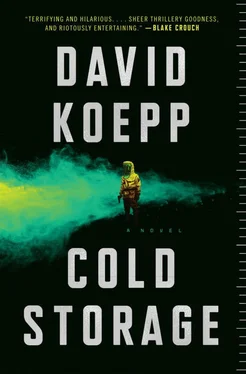For Teacake it was the bloated deer.
The animal was standing at the end of the short hallway, just staring at them. This in itself wasn’t a big deal, that was sort of what deer did, they stood there and stared at you, frozen, wondering how it’s all come to this. But this deer’s insides were moving, you could see it in every breath it took. Either it was about to give birth, or it had eaten something that seriously disagreed with it.
Naomi saw it and stood, slowly, phone in one hand and the other held out to the deer as if to say, Wait. You don’t make sense.
The deer lifted its chin and made a grotesque hacking sound at them.
Teacake climbed out of the manhole, slowly, and stood next to Naomi.
“What’s the matter with it?” he asked.
“It’s sick. Distended belly.”
The deer took a couple of steps toward them, hacking some more. Teacake picked up the pry bar he’d used to open the manhole cover.
“Don’t,” Naomi said.
“Tell it not to come any closer.”
She looked at him. “Like I talk to animals?”
“Wait a minute,” Teacake said. The deer froze again, as if obeying him. Teacake thought. So, okay, sick deer staring at them, but this sick deer was in an underground storage facility, all the way down in sub-basement 1. There’s only one way it could have gotten to SB-1. The elevator.
“How the fuck did it get down here?”
The deer cocked its head suddenly, as if called, then turned around and trotted back toward the mouth of the hallway, throwing a look back over its shoulder to hack at them one more time. It rounded the corner, only a bit unsteady, considering deer hooves were not at all made for concrete, and then clattered off and out of sight, its steps echoing off the walls.
Teacake and Naomi glanced at each other, but neither one needed any convincing. They followed it.
They came around the corner but were falling behind the thing. It had picked it up to a trot and was just now turning a second corner, at the far end of the hallway. They walked faster. They turned a final corner, and this one came to a dead end at the only elevator. The deer trotted toward it.
Teacake and Naomi slowed, approaching it warily.
“Uh, what do we do once we catch it?” he asked.
“I don’t want to catch it,” she said. “I want to help it get out of here.”
The deer reached the elevator doors at the far end and stopped, looking back over its shoulder at them.
Teacake walked even slower. “I’m not getting in an elevator with that thing.”
At that moment, the elevator doors binged and slid open. The deer turned, as if fully expecting that, click-clacked its way into the elevator, turned back around to face them, and, swear to God, it glanced up at the floor numbers as the doors slid shut.
Teacake and Naomi stared.
Teacake spoke first. “The fucking deer just took the fucking elevator.”
Naomi looked around, as if seeing the walls on either side of her for the first time.
“What the hell is this place?”
Consider the night the deer was having. After the animal’s execution by Mike’s handgun at the side of Highway 16, it had gone through a period of blackness from which it abruptly awakened in the trunk of a car with a lunatic, half-faced cat standing on top of it. Cordyceps novus, having pulled off the seemingly impossible migration into the trunk of the car, had spent more than eight hours marinating inside the helpless creature’s brain. The fungus had gone to work to repair damage from the bullets, in the process rewiring neural connections to alter the animal’s behavior. The amygdala was expanded; the frontal cortex was inhibited. All the animal’s basic instincts—eat, reproduce, run away—had been subordinated to the primary goal of helping the fungus sporulate and disperse.
The deer didn’t have much in the sense of wonder, so it had no interest in trying to puzzle out how a pathogenic, mutating fungus that had been stored in a sealed subterranean environment ended up aboveground in the trunk of a ’96 Chevy Caprice in the first place. Still, it’s a question worth asking.
By the early 1990s, the Cordyceps novus sample that had been recovered in Australia and stored at Atchison was brutally unhappy. When you have one biological imperative and that imperative is thwarted, it gets pretty depressing. But even though the temperature inside the biosealed tank was fourteen degrees below zero and the fungus was nearly inert, fourteen below zero is still a lot warmer than absolute zero. And nearly inert is not at all the same thing as completely inert.
Deep underground, sealed in a tank that was shut in a box that was locked in a crate, the fungus continued its pattern of consumptive evolution, albeit slowly, given the temperature and the inhospitable chemical composition of the stainless steel tube itself. Manganese and aluminum were abundant in its makeup, but they were of almost no use, given their nonreactive nature. A full 16 percent of the tube was chromium, which was actually a growth inhibitor for Cordyceps novus, so that was a downer, and carbon, which was what the fungus truly craved, made up a scant 0.15 percent of its chemical surroundings.
The fungus did grow. But barely.
Still, time marched on. By 2005, after almost twenty years of ceaseless effort, the fungus had managed to transform and occupy an area of the tube a few microns square. Through that tiny opening the fungus trickled out into the larger storage container in which the tube rested. It picked up a little nourishment from the polyurethane foam in which the tube was nestled—at least poly had more than two reactive hydroxyl groups per molecule, a fungus could work with that—but it wasn’t until it made its way through the portable sample kit’s outer shell, in late 2014, that Cordyceps novus hit its digestive stride.
Because the outer box, the big one, the crate Roberto and Trini had watched so carefully in the back of the truck twenty-seven years before, was made of carbon fiber.
Superfood.
The fungus was out of containment and loose in the sealed room at this point, but still slowed by the underground temperature. Slowed, not stopped. The powerful cold spring, fed by the deeper undercurrents of the Missouri River, had spent most of the twenty-first century warming up along with the rest of the planet. The river surface got hotter; the spring got hotter. The ambient temperature inside sub-level 4 had risen seven degrees since the fungus had first been incarcerated, and the temperature only went up as the fungus produced its own chemical reactions. Its conquest of the sealed room was completed by midsummer of 2018.
The fungus oozed through the wiring in the wall in the autumn of that year and spread into the main corridor of SB-4 in November. An unusually cold winter delayed its growth briefly, but when a record-breaking heat wave hit in early March of this year, Cordyceps novus got the few extra degrees it needed to crank up its metabolic machinery. It infected organic matter again for the first time since its birth in Australia.
That was when it found the roach.
The American cockroach has several impressive evolutionary characteristics, besides its ability to survive a nuclear winter. One is that it can live without its head for up to a week. Respiration occurs through small holes in each of its body segments, so even after the first Cordyceps novus /cockroach hybrid was decapitated in a snarl of mayhem with a dozen other infected roaches who attacked and tried to consume each other, C-nRoach1 was able to continue on its purposeful way.
And it did have a purpose. From the moment of its hijacking, C-nRoach1 became imbued with a biological purpose greater than any roach in history. That’s saying something, for a 280-million-year-old genus.
Читать дальше
Конец ознакомительного отрывка
Купить книгу











